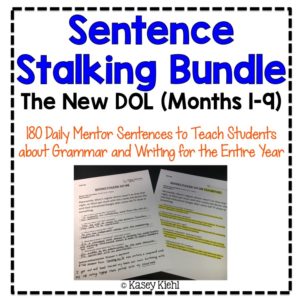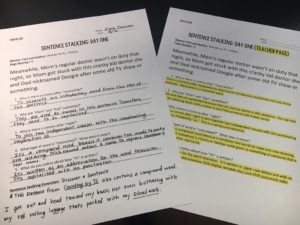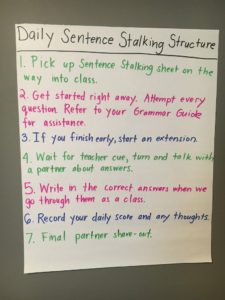In Jeff Anderson’s book Mechanically Inclined, he credits Vicki Spandel for coming up with the term “sentence stalking.” Ever since I read about what it meant to be a sentence stalker, I couldn’t get it out of my mind. It just made sense. Sentence Stalking is described as showing students a great mentor sentence (from a book, newspaper, student writing, etc.) and having students notice what the writer did to create that sentence and why.
I grew up with the traditional DOL system where at the beginning of language arts class each day the teacher would ask us to examine a sentence that contained an obscene amount of errors and identify what we would do to “edit” this sentence. This practice doesn’t make sense on so many levels. We are literally giving students a daily picture of what it means to be a horrible writer and then expecting that this practice will turn them into a successful one. It would be like showing students the wrong spelling of a word over and over again and then asking them to spell it correctly.
Our brains soak in every visual thing that we see, and if we see these horribly crafted sentences with ten errors in them over and over again during DOL, doesn’t it just make sense that this would have the potential to harm our writing instead of help it? This is where sentence stalking comes in. I have scoured novels and nonfiction books that middle school students love in order to pick out “sentence stalking worthy” sentences. These sentences contain rich words, strong writing craft, and creative sentence structure. These are the sentences we want our students to study and take mental images of so that they try out these same types of writing techniques in their writing.
After years of trying out Sentence Stalking in my classroom, I am beyond excited to share this resource with you. I have used Sentence Stalking in a variety of ways, and I am proud to say that the way I have structured this resource brings together my most powerful takeaways from using Sentence Stalking and puts everything I know into one practice that students will respond well to. It is my sincere hope that your students will respond to Sentence Stalking in a way that transfers what they learn about sentences into their own writing, and that it also enhances their understanding of grammar and writing conventions.
The resource is designed so that each day, students study a new mentor sentence. Each mentor sentence is accompanied by focus questions to get students thinking about the sentence on a variety of levels. The focus questions deal with the following types of topics: parts of speech, punctuation, spelling and spelling patterns, capitalization, analyzing the writer’s craft, sentence structure, vocabulary, using context clues to find word meaning, denotative and connotative meaning of words, root words, prefixes and suffixes, figurative language, and more.
Each day contains a teacher answer-guide along with ideas for teaching points to coordinate with the daily mentor sentence and focus questions. It is the perfect way to teach grammar without having to lecture or do drill and kill worksheets to learn one isolated grammar concept at a time.
You will never see sentences the same, and your students will never see sentences the same. Sentence Stalking takes the sometimes intimidating, sometimes completely dry task of teaching about grammar and writing conventions and makes it into what is sure to be one of the best parts of your class period.
 |
| View this resource on my TpT Store here |









